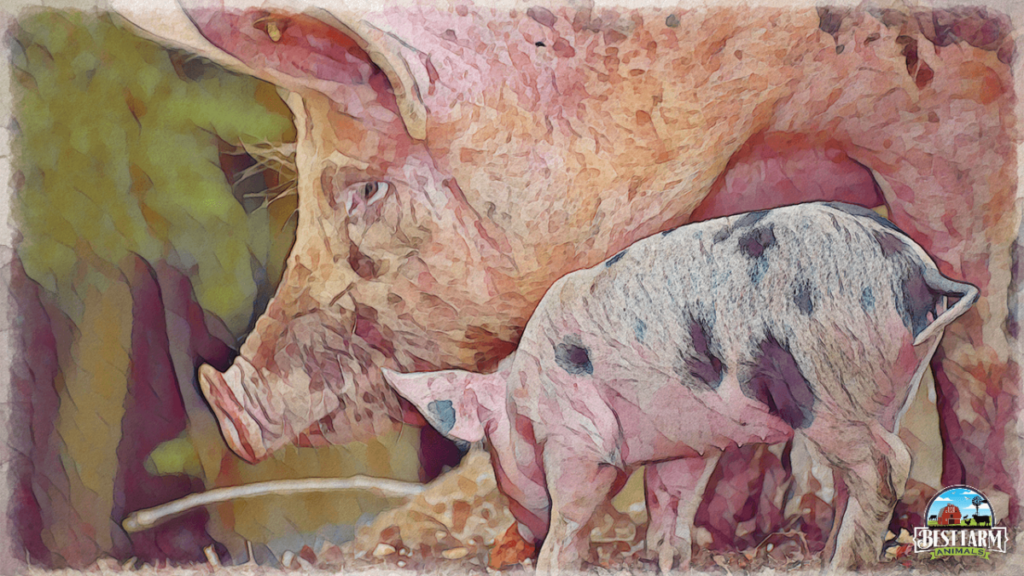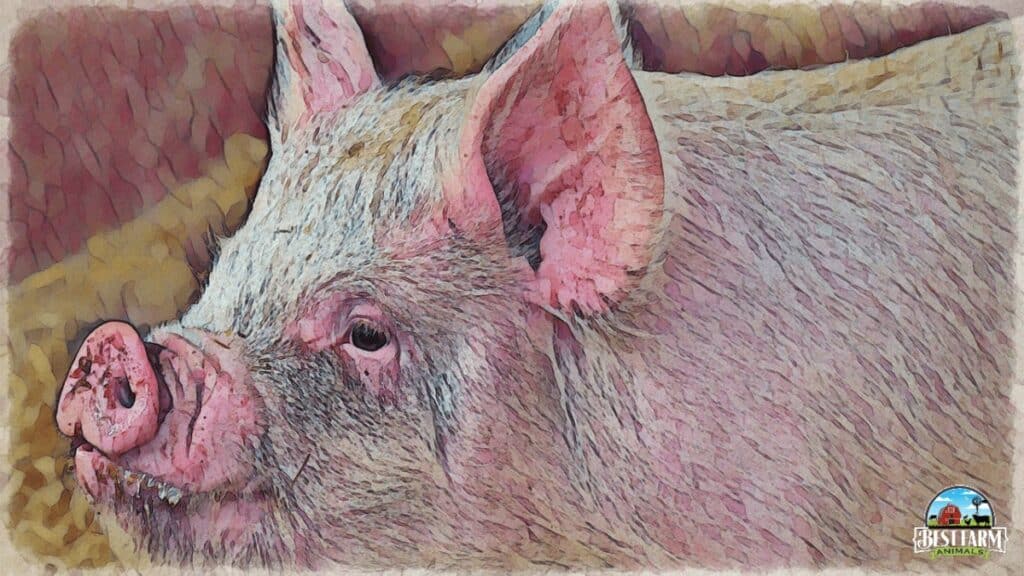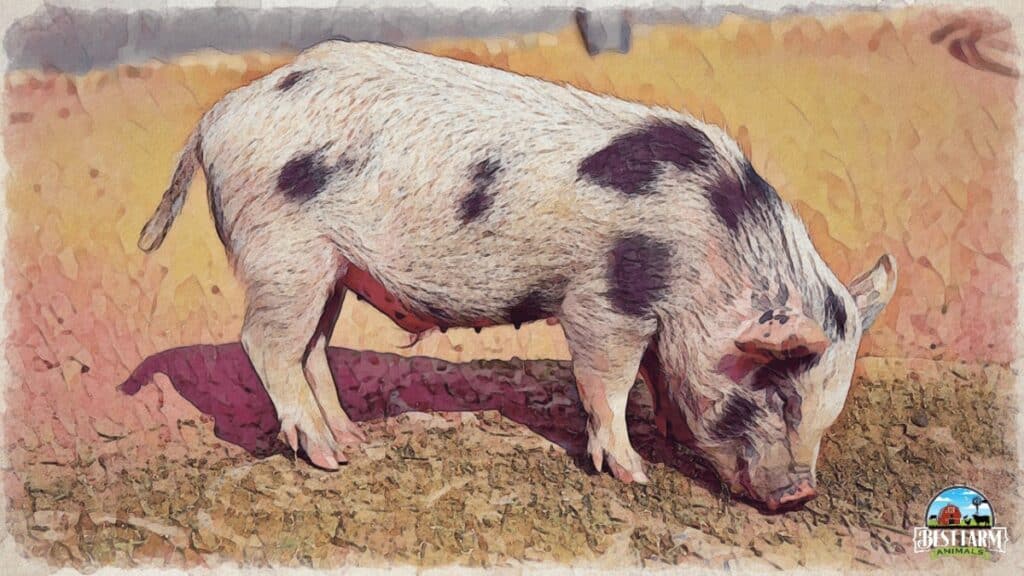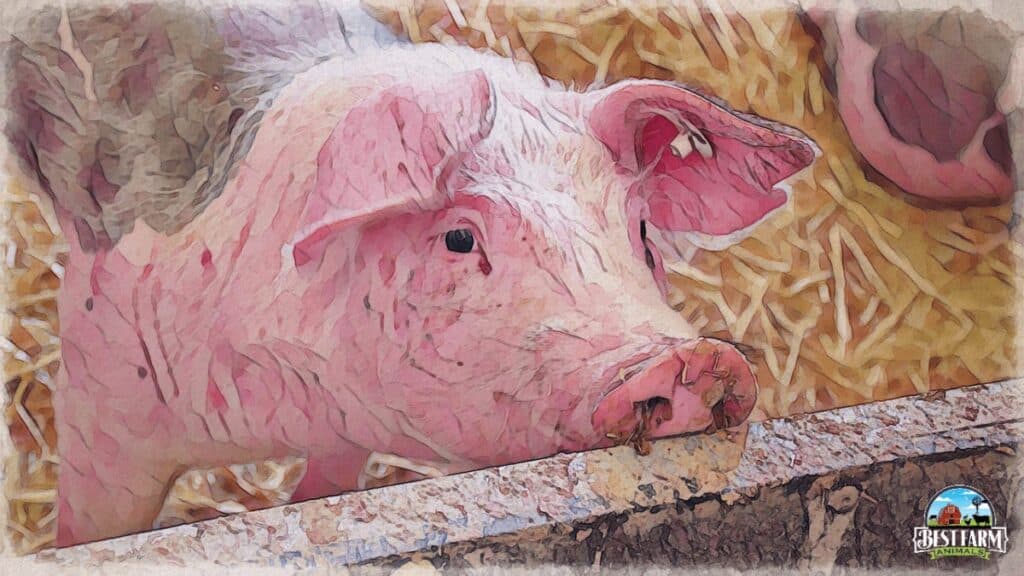- My Most Used Pig Supplies
- Scratching Pig: Best Treatment For Itchy Pigs
- 1. Sarcoptic Mange Mites In Pigs Causes Red Spots on Pig Skin
- 2. Pig Lice Gets Your Pig to Scratch Walls and Floors
- 3. Allergic Reactions Cause Coughing and Scratching Pig
- 4. Insect Bites Cause Rashes
- 5. Dippity Pig Syndrome Forces Pigs to Walk on Hind Legs
- 6. Pig Sunburn Causes Skin Irritation
- 7. Pigs Get ‘Mad Itch’ And Lose Appetite
- 8. Pigs With Swine Pox Have Red Spots And Scabs
- 9. Greasy Pig Disease or Pig Epidermitis Affects Piglets Often
- How to Keep My Pigs Skin Moisturized?
- Pig Scratching FAQs
- Conclusion
Gus is my adorable mini pig; he lives mainly indoors with my family when we are home. He is quite a spoiled little piggy and has his own room just outside our kitchen, where he sleeps at night.
About four nights ago, I noticed that Gus had sniffles and was frequently scratching. Shortly after that, he started rubbing himself against my furniture and trying to scratch at what appeared to be an itchy spot. I didn’t pay much attention at first, as pigs enjoy a good scratch from time to time. However, I saw that this insistent itch started driving Gus crazy.
I decided to bathe him and noticed an inflamed rash on his skin. Concerned, I contacted our local vet and described the symptoms that Gus was experiencing. She prescribed some topical cream, and it worked well.
That is until three days later when the same rash flared up again. I took little Gus to the practice for bloodwork to help us determine what was going on with him.
Is it normal for pigs to scratch? It’s very normal for pigs to scratch. Pigs are avid scratchers and have strong claws. They might scuff their skin against nearby objects or fences. But excessive scratching might be a sign of an infection or skin condition.
Pigs can develop skin conditions like pig mange, which itches, can result in hair loss and skin lesions, among other things. Pig lice can also itch and irritate the skin. It’s crucial to keep an eye out for any symptoms of skin irritation or an infestation in pigs and to seek treatment as needed.
It’s important that you be able to recognize if your pig is scratching because of a serious condition or not. I’ll cover what to watch for in this article. Let’s dive in.
Scratching Pig: Best Treatment For Itchy Pigs
Let’s take a closer look at seven reasons why your pig is constantly scratching the walls, the floors, or its body, and how to stop them:
1. Sarcoptic Mange Mites In Pigs Causes Red Spots on Pig Skin
Sarcoptic Mange, or mites, is an unpleasant (and common) cause of scratching pigs. It’s a parasitic disease also known as scabies. Unfortunately, it’s commonly underdiagnosed and should be one of the first causes you investigate when your pig is itchy.
You may know Sarcoptic Mange by these names:
- Sarcoptic Mange
- Pig Mites
- Scabies
Mange is highly contagious and spreads from direct skin-to-skin contact with a mite-infected pig or a recently contaminated surface area. Male pigs are known to spread mites quickly as they are usually in direct contact with females when breeding.
These nasty host-specific parasites create scaly and rough skin that causes intense itching all over your pig’s body. The area often becomes inflamed and bleeds due to continuous scratching and licking.
A tell-tale sign of a mite infection is when you notice your pig scratching behind their ears vigorously and often shaking their heads from side to side. If your pig has become hypersensitive to the scabies mite, they’ll form small, pimple-like lesions all over their body. This usually occurs about three to eight weeks after infection).
Eventually, thick crusts of flaky skin will form behind your pig’s ears, hind legs, and elbows, which causes extreme discomfort. Basically, the mites dig into your pig’s skin and feed on them.


2. Pig Lice Gets Your Pig to Scratch Walls and Floors
Pig lice is another culprit of severe itchiness and scratching in pigs. These pesky parasites hide amongst the hairs on your pig’s skin. The louse is yellowish-brown and usually found in the fat folds around your pig’s neck, inside (and outside) their ears, legs, and flanks.
Each lice feeds off your pig and has mouth parts designed for piercing and sucking on the pig’s skin. Once the lice has fed, they develop a bluish coloring. In severe infestations, the lice can be found all over the body feeding on your pig, and the skin develops lesions from the continuous scratching and rubbing against fences, etc.
If you look closely at your pig’s skin, you’ll notice the eggs, which appear as yellow, crusty patches on the bristles of your pig’s hair. The eggs will hatch after 12 days, and the lice will be fully developed between 29 to 33 days.
Did you know: that the louse can also be a vector for the swine pox virus? So it’s vital to treat the infestation and avoid further infection.

3. Allergic Reactions Cause Coughing and Scratching Pig
Just like us, pigs also suffer from allergies. They can have allergic reactions to different materials, environments, and food. These allergies attack their skin, intestinal tract, and respiratory tract, which can cause discomfort.
Certain allergies affect your pig’s skin which causes abscesses, lesions, or dry skin that leads to intense itching. It’s important to remember that each pig is unique, and certain things will trigger an allergic reaction.
Here’s a quick list of a few everyday things that can trigger an allergic reaction in your pig:
Like humans, pigs can develop allergies to certain foods such as nuts, soya, flax, and linseed. The pig’s immune system becomes sensitive to the protein found in nuts and seeds.
Things like moldy food and parsnip tops can also trigger an allergic response. Environmental factors such as hay, straw, pollen, and dust can also flare up an allergic reaction when the pig breathes it in.
Pigs are also allergic to insect bites and parasites whose saliva irritates the pig’s immune system. Be mindful of the types of insecticides and pesticides you use in your pig’s living environment, as this can also cause allergies.
- Hay, straw and bedding
- Food allergies (apple seeds, mushrooms, beans, tomato leaves and other slightly toxic foods to pigs)
- Pollen
- Parasite reactions
- Dust

4. Insect Bites Cause Rashes
Biting insects such as ticks, mosquitoes, sand flies, and horse flies can cause severe irritation and rashs. The saliva from these insects causes an allergic-type reaction and can make the skin very itchy.
Even worse is when these insects attack in numbers and bite your pig all over their body. Mosquitoes, in particular, can be pretty troublesome. A mosquito pierces the pig’s skin with a proboscis (funnel-like mouthpart) which it uses to suck up the blood.
While it feeds, it injects saliva back into your pig’s skin. Your pig’s body then reacts to the saliva and begins to itch as the skin develops an inflamed, red bump. The more your pig scratches and rubs the mosquito bite, the itchier it becomes.
Female sand fleas (Tungiasis) will burrow into your pig’s skin and lay their eggs while they feed off the pig’s blood vessels. This is an excruciating condition; the bites are located on your pig’s feet, between their toes and legs. The fleas are often found in stables or barns and thrive in warm conditions.
5. Dippity Pig Syndrome Forces Pigs to Walk on Hind Legs
Dippity pig syndrome, also known as bleeding back syndrome, is a horrible disease for pigs to contract. Sunburn and sudden loud noises such as thunder can bring on flare-ups of this condition.
This skin condition develops along a pig’s hindquarters and back, creating painful sores that weep pus and blood. This awful disease also causes weakness in your pig’s back legs. According to research, this disease is hereditary and typically affects younger pigs.
This syndrome gets its name because an infected pig has a temporary loss of use of its hind legs and has to make a “dipping” motion to move. Interestingly, the syndrome does not affect the front legs.
The exact cause of Dippity Pig syndrome is not known as yet, but scientists believe that it may involve the herpes virus (similar to shingles).

6. Pig Sunburn Causes Skin Irritation
A fun fact about pigs is that they sometimes sunbathe for hours. However, this can be dangerous for their sensitive skin, especially during summer. The ultraviolet radiation from the sun penetrates their skin and causes cellular damage.
Sunburned skin is no fun for your pig and can cause a lot of discomfort. Lying in the sun for too long leads to dry skin, peeling, scratching, and itching. Your pig cannot sweat, which means their skin will dry out even quicker, and this can cause further aggravation.
7. Pigs Get ‘Mad Itch’ And Lose Appetite
Mad itch is a disease that drives pigs mad with scratching, and that’s why Pseudorabies is called the “Mad Itch.” Aujeszky’s disease (also known as Pseudorabies) is a strain of the DNA herpes virus that attacks your pig’s immune system.
Unfortunately, as a result, your pig will be susceptible to other diseases and infections, as their weakened body won’t be able to fight off bacteria. This can lead to severe illnesses or death if not caught in time.
Patches of skin develop concentrated and intense itchiness, which causes your pig to rub, lick, and chew at the itchy skin. Doing this causes lesions, which lead to further irritation and itchiness.
Did you know: Pigs can carry Aujesky’s disease and not show any symptoms of infection?
The “mad itch” disease is most common in young pigs and is deadly for piglets under seven days old. This herpes virus is highly contagious and can spread as an aerosol for about 1.24 miles.
Nose-to-nose contact and ingesting contaminated feces is another way this disease is spread between the herd. The virus can survive for up to seven hours in water and two days in contaminated pig feces.
8. Pigs With Swine Pox Have Red Spots And Scabs
Another disease that causes pigs to scratch and itch is swine pox. This vesicular (blister-like) disease is caused by the swine pox virus. This is a highly contagious disease that’s spread by mange mites, lice, and open wounds on the skin.
Swine pox is a resilient virus that can survive outside the pig for extended periods. The virus is not affected by environmental changes, and the lesions are typically found along the pig’s flanks, abdomen, and on their ears.
A typical swine pox lesion looks like a small blister that’s filled with straw-colored fluid in the center. After three days the blister ruptures and forms a black scab.
The most obvious sign that your pig has swine pox is the blister-like rash that forms on their skin. Other symptoms to watch out for include conjunctivitis (pink-eye), obvious discomfort, and chewing around the flank area.

9. Greasy Pig Disease or Pig Epidermitis Affects Piglets Often
If your pig has greasy pig, you may notice excessive scratching. Exudative epidermitis, better known as “greasy pig disease,” is a localized skin disease affecting pigs of all ages, especially piglets. This bacterial disease gets its nickname from the discolored crusts of flaking and greasy skin that can cover the pig’s entire body.
The staphylococci bacteria (aka the culprit) produce toxins that damage the pig’s liver and kidneys, and sadly it can be fatal for piglets if not treated in time. Look out for lesion formations around your pig’s face and legs. The lesions ooze fluid and give the inflamed skin a greasy feel.
In severe cases, the greasy skin patches can turn black due to necrosis, which can be fatal as too many toxins are accumulating in the pig’s body.
How to Keep My Pigs Skin Moisturized?
There are a number of ways to keep your pig’s skin moisturied and itch-free..
What Lotion Can I Use on Pig Skin? Keep your pig’s skin moisturized using a lotion rich in vitamin E, such as Luster’s Pink Lotion. This will help alleviate itching from dry skin. I wouldn’t use most human lotions on your pig. Most human lotions can irritate pig skin. Instead, use coconut oil and aloe-based oils for moisturizing pig skin.
Some people use Swine Conditioner and Shine as spray-on conditioner to enhance the appearance of show pigs.
However, it is important to note that before using any new lotion on your pig’s skin. Use a small amount first in case of any allergic reactions.
Washing You Pig: Gentle soaps such as Johnson’s baby shampoo and Dawn dish soap are good for moisturizing your pig’s skin. A natural option to try is rubbing coconut oil onto their skin as it’s high in fatty acids, which helps the skin retain its moisture.

Pig Scratching FAQs
Pigs have sensitive skin and often suffer from dry and flakey skin. An itchy pig is unhappy, so relieving the itchiness as soon as possible is important.
Do pigs like being scratched?
In general, pigs love to be scratched. Pigs naturally have dry skin and often can’t reach the itchy spot, which can cause increased frustration and aggression. So having someone scratch them relieves their discomfort, stimulates nerve endings in the skin, and is enjoyable. Pigs also relax when they’re being scratched.
Why do pigs roll over when you scratch them? Pigs enjoy being scratched, so when you do, they roll over because it feels good. In pigs, scratching can stimulate skin nerve endings, resulting in a pleasurable reaction. They can expose more of their body to being scratched by rolling over, which can make the pain worse.
Pigs also frequently depend on other pigs or people to scratch them in places they can’t reach because of their body shape, which limits their mobility when it comes to scratching themselves. Pigs can also show their comfort and trust in humans by rolling over.
Do Pigs Like To Be Petted? When handled properly, pigs can enjoy being petted. Pigs have unique personalities and preferences, just like other animals, so some may prefer physical contact more than others. Some pigs might prefer to only have certain areas touched, like the area under their chin or behind their ears, while other pigs might not like any touching at all.
Where Do Pigs Like To Be Scratched? Most pigs like to be scratched around their ears, under their chin, or on their belly. It’s crucial to approach pigs calmly and gradually, giving them time to get used to you before attempting to pet them. Pigs are highly sensitive to touch and are easily startled if they are suddenly or unexpectedly touched. In order to prevent unnecessary stress or harm, it is also crucial to always approach and handle pigs with kindness and respect.

Conclusion
Taking Gus to the vet was the best thing we could have done. It turns out that Gus had developed an allergy to the straw we used as bedding for him and that’s why he was constantly scratching. Thinking back on it now, I had recently changed his bedding from hay to straw.
I threw out all the straw and thoroughly cleaned his room before putting down some good-quality hay for him.
The vet also advised that I keep some antihistamines on hand just in case he flared up again. Another tip she gave us was not to bathe Gus too often, as it strips away his natural skin oils, which keep his skin moisturized. I am happy to report that it’s been two months since we changed his bedding to hay, and there have been no more flare-ups.
Once you know your pig isn’t sick, giving pigs access to environmental enrichment opportunities like scratchers can encourage their natural behaviors and lessen stress.
References:
Research Gate Published Study
Virological Characterization of Pigs with Erythema Multiform
MSD Vet Manual:
My Most Used Pig Supplies
This list contains affiliate products. Affiliate products do not cost more but helps to support BestFarmAnimals and our goal to provide farm animal owners with accurate and helpful information.
Purina Pig Chow will last well (or Mazuri is popular, but I haven’t tried it), and the stainless steel non-skid bowls that will help keep the mess down.
A pig blanket to keep her warm. This one also has bright colors and helps to provide rooting without the destruction.
Pig Harness for walking and handling your pig. There are a lot to choose from, but this one is pretty easy to use. If you want one that has a separate leash, this looks like a good one.
A large crate for keeping her safe in your house at night and when you leave the house. This is essential. You’ll also want a litterbox, and I like mine with a lid for nighttime. Pine shavings are best, and you may be able to find them in larger quantities locally.
When you have accidents, Odoban will help eliminate odors. When you are potty training, these floor pads work great for keeping your house clean while training her to go in certain places.
You’ll also want an outdoor house to keep her warm when she gets outside time, an essential part of her development.
Dewormer- Ivermectin is the primary dewormer I use, although I do rotate with a non-ivermect ingredient once so that the worms don’t get immune to it.

